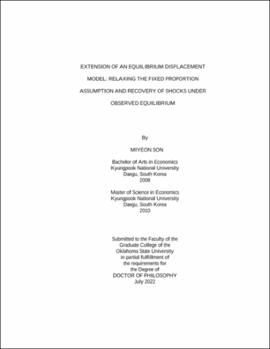| dc.contributor.advisor | Lambert, Dayton M. | |
| dc.contributor.author | Son, Miyeon | |
| dc.date.accessioned | 2023-04-05T16:21:21Z | |
| dc.date.available | 2023-04-05T16:21:21Z | |
| dc.date.issued | 2022-07 | |
| dc.identifier.uri | https://hdl.handle.net/11244/337326 | |
| dc.description.abstract | The goal of this research is to extend a conventional equilibrium displacement model (EDM) to one that permits substitution between inputs. The empirical example evaluates economic shocks and their effects on social welfare for the United States (US) food industry linking 24 agricultural commodities and nine retail food products markets. Lusk (2017) and Okrent and Alston (2012)’s (LOA) EDM is used to achieve the research objectives. | |
| dc.description.abstract | The first essay evaluated the effects of the Coronavirus Food Assistance Program (CFAP) on producer and consumer surplus in the US food industry. The LOA-EDM is extended to accommodate constant elasticity of substitution (CES) production technology; thereby relaxing the fixed proportion technology assumption of the LOA-EDM. Findings indicate that CFAP payments not only distributed benefits to producers of various food commodities but also to food consumers via lower food prices. Allowing for input factor substitution resulted in less conservative (larger) estimates of the distributional impacts of CFAP policy on social welfare. Overall, results suggest that welfare measures may be underestimated when an EDM employs fixed proportion technology. | |
| dc.description.abstract | The second essay develops a method for employing an EDM to estimate the effects of inflation on welfare measures. Year-over-year changes in price inflation rates reflect changes in demand and supply. Unknown are the underlying shocks driving inflationary trends. This complicates the estimation of the impacts inflationary trends have on consumer and producer surplus. The LOA-EDM is recast of as an ‘Equilibrium Replacement Model’ (ERM), which recovers the implied shocks that lead to observed proportional changes in prices and quantity demanded throughout the food sector. The shocks are regressed against gross domestic product and energy prices to establish a relationship between these macroeconomic variables, the estimated shocks, and changes in welfare over 1993 to 2019. That is, given a percent change in a macroeconomic variable, the percent change in a sector-specific shock can be determined and then applied to find corresponding changes in welfare. The results show that social welfare changes caused by shocks in the food sector have risen continuously, and the retail food market is more influenced by changes in macroeconomic variables than the agricultural market. | |
| dc.format | application/pdf | |
| dc.language | en_US | |
| dc.rights | Copyright is held by the author who has granted the Oklahoma State University Library the non-exclusive right to share this material in its institutional repository. Contact Digital Library Services at lib-dls@okstate.edu or 405-744-9161 for the permission policy on the use, reproduction or distribution of this material. | |
| dc.title | Extension of an equilibrium displacement model: Relaxing the fixed proportion assumption and recovery of shocks under observed equilibrium | |
| dc.contributor.committeeMember | Brorsen, Wade B. | |
| dc.contributor.committeeMember | Lambert, Lixia H. | |
| dc.contributor.committeeMember | Zhu, Lan | |
| osu.filename | son_okstate_0664d_17771.pdf | |
| osu.accesstype | Open Access | |
| dc.type.genre | Dissertation | |
| dc.type.material | Text | |
| thesis.degree.discipline | Agricultural Economics | |
| thesis.degree.grantor | Oklahoma State University | |
